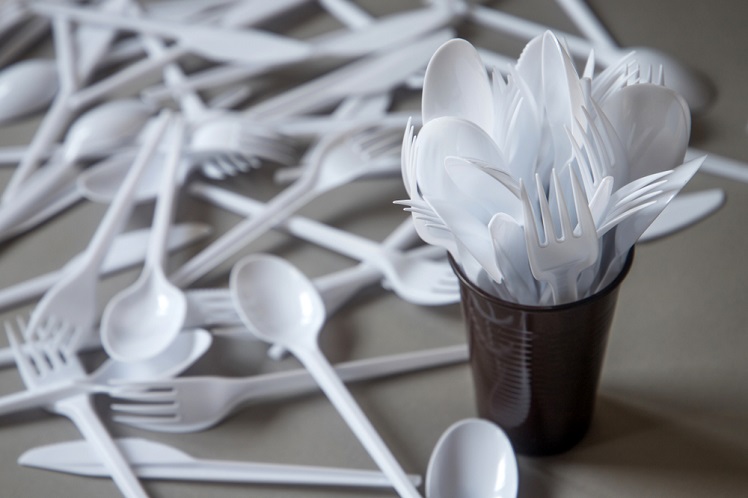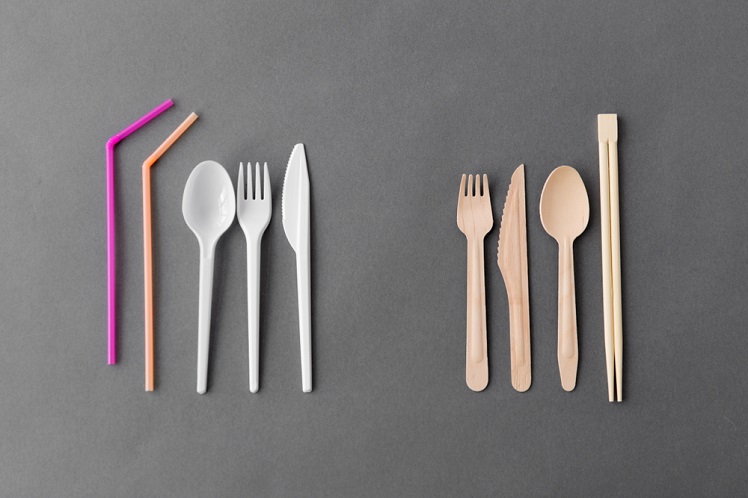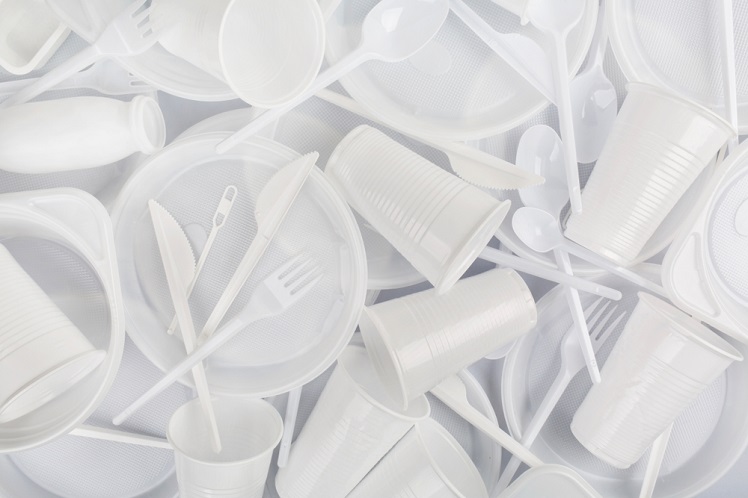Over the years, plastics have become a vital part in our modern lives. We are compelled to include plastics in every facet of our life. Mostly these are based on carbon or silicon atoms. In fact, plastic utensils are one of the highest products wasted per year. Do you know that Americans use more than 561 billion separate plastic utensils annually?
Mostly these are based on carbon or silicon atoms. These elements deadly contribute to health problems in humans and animals. Apart from it, these materials are cluttering up our societies, cities and oceans. To overcome the plastic issue, Crystallized Polylactic Acid (CPLA) cutlery is a perfect solution!
CPLA is a brand-new kind of biodegradable material to save our planet. It is made from crops like corn, cassava, and others that can be grown again. Microorganisms use it to ferment and extract lactic acid, which is subsequently purified, dried, oligomerized, pyrolyzed, and polymerized into PLA (Polylactic Acid).
These can easily be broken into their component parts to recycle them. The crystallization process makes this material more durable and ideal for tableware such as spoons, cups, and even food trays.

Do you want to be part of a better world? You can start from small little things such as changing your plastic cutlery with more eco-friendly materials. If you are planning to reduce plastic usage by utilizing CPLA products, there are more facts about this biodegradable material you should know.
From the introduction of CPLA and its making process to the advantages of CPLA cutlery, we’ve prepared them all in this article below. Let’s dive in!
Table of Contents
What Is The Difference Between PLA and CPLA?
In short, CPLA is the stronger version of PLA. CPLA is crystallized PLA, however it shares the same benefits for the environment as PLA. They also have different melting points which makes them used for different purposes and products. Here are some advantages and product examples of PLA and CPLA to give you better understanding.
1. PLA (Polylactic Acid)
PLA is made by fermentation using waste products from the food or agricultural industries as well as renewable resources including sugar feedstock, wheat, maize, and corn to controllably polymerize lactic acid monomers.
Since PLA has a lower melting point than many fossil-based polymers, it’s best for cold use up to around 40ºC or 105ºF. Therefore, PLA is usually used as a biodegradable packaging material, film, or for compost bags.
2. CPLA (Crystallized Polylactic Acid)
CPLA is formed by biodegradable materials, similar to PLA. However, it’s crystallized by applying high pressure and heat to PLA. As a result, the material becomes tougher and less prone to heat damage.
Moreover, CPLA products have higher heat-resistance up to 90ºC or 194ºF. For coffee cups, soup containers, and other hot goods, CPLA is a great substitute for plastics like polystyrene since it can endure greater temperatures.
What Is CPLA Cutlery?
CPLA cutlery is a heat-resistant variety of PLA which is derived from plants and can be used to make injection-molded objects like hot cup lids, trays and lids, reusable mugs, cutlery, straws, plates, and bowls for restaurants. It can be created from any sugar, such as sugar cane or sugar beet, but is most frequently supplied from corn because of the huge volume that can be produced.
Moreover, CPLA is of the finest caliber and is constructed of the best starch-based materials. The starch is collected from the maize plants in the form of glucose, which is subsequently changed into lactic acid.
After that, lactic acid undergoes a chemical transformation to become a polymer, and lastly, a resin. When it comes to eco-friendly cutlery, CPLA products are the right answer.

1. What Is CPLA Cutlery Used For?
Since CPLA cutlery is heat resistant, you can use them for hot foods like soups and meats. It is also utilized for things like trays and large cutlery where a less flexible material is required. Restaurants or larger F&B industries benefit from the CPLA tableware.
Besides, home industries who want to support the green movement also can use CPLA cutlery for their food packaging. Because it is biodegradable, it can be thrown away without endangering the environment.
2. Cutlery Products That Made From CPLA
CPLA is a superior option when you require bulkier restaurant supplies with a more robust structure. Large implements like serving spoons or tablespoons fall under this category.
Additionally, huge trays for catering services can be produced using CPLA. It is also frequently utilized to create lids for environmentally friendly food containers.
Karat Packaging and Agreen Products are some manufacturers that produce CPLA spoon, fork, cup, and knife. The product consists 70-80% PLA and 20-30% chalk. Therefore, you may find white CPLA products because of chalk as the catalyst.
CPLA Cutlery Production Process
CPLA cutlery has a long production process before it is placed on your table. Starting from the compostable, heat-resistant PLA is used to make CPLA, which is created without any plastic at all.
The process requires chalk, biodegradable and biobased additives, high pressure and heat to crystallize the PLA. As a result, the material begins to crystallize and becomes tougher.
After that, it is processed as CPLA extruded sheets. It is constructed of the best starch-based materials. To make CPLA products, put CPLA sheets inside the thermoformer. Using this machine, the CPLA sheet creates parts such as food trays, lids, containers, and coffee cups. Following that, parts are mechanically ejected onto a packing station.
Pros and Cons CPLA Cutlery
CPLA is a substance that is entirely derived from natural and renewable resources. When many people believe this is the sustainable product that will save the planet, some people also put some considerations.
Before buying CPLA products, here are some pros and cons you should know. Let’s check this out!
1. Benefit of CPLA Cutlery
The characteristic of CPLA material can be the main advantage of CPLA cutlery products. Besides, it supports a green lifestyle since it uses renewable resources. Here are some benefits of CPLA products to give you better understanding:
- Heat-Resistant: CPLA can sustain substantially higher temperatures than conventional PLA. It is therefore practical for hot products like food, coffee, and soups.
- Less Carbon Emission: As these products are broken down using natural bacteria, they hardly emit any carbon or methane in the atmosphere. Additionally, these are plant based products!
- Recyclable: In addition to the quality to break down into humic elements, biodegradable products can be easily recycled to create more plastic products. Its integrity is ensured by the plant based oils used in their production.
- Compostability: With traditional biodegradable paper products and yard, this trash can easily convert into rich humic material. These converted materials improve water and nutrient retention of land and help to grow healthier plants.
- Eco-friendly Disposable Solution: Biodegradable products require recycling to ensure proper breakdown of the trash. Only, then the natural composting process begins! The proper process automatically reduces the amount of waste left.
2. Negative Impact of CPLA Cutlery
Since this product is made by plants, the disposal method, price, and material resources will be the main disadvantages of CPLA products. Let us elaborate more in the following points:
- Landfill Impact: CPLA will increase the acidity of its surroundings in any disposal technique if it is not properly disposed of, whether in a household or commercial composting facility, which can result in minor complications.
- Expensive: Although this is the best environmentally friendly option, CPLA is more expensive than disposable plastic cutlery. This is because CPLA uses natural ingredients with complicated production processes.
- Corn Corp Issue: Since CPLA is mostly made by corn starch, the source material is often being modified genetically (GMO). The corn crop is not viewed as being ecologically beneficial because traditional cultivation can cause toxic runoff into streams and rivers and erode soil.
Afterall, the advantages of using CPLA products still surpass the advantages of conventional plastics, which are based on petroleum and inflict far more damage to the environment over the course of both the short and long terms.

How Long Does It Take CPLA Cutlery To Break Down in Nature?
When disposed of properly, CPLA, which is plant-based and created from a renewable resource, can biodegrade in less than two weeks. In industrial composting systems, CPLA also can be composted. CPLA typically takes 2 to 4 months to compost.
In the CPLA composting system, the ideal temperature must be above 55ºC-70ºC for CPLA to compost. Keep relative humidity of the compost in 50 ± 10%. Consider external factors such as lower temperature during rainy or winter season since these factors should be maintained
Final Thought
In the end, CPLA cutlery gives us an eco-friendly biodegradable option to reduce plastic usage. The attractive advantages of CPLA over conventional plastic are its advantages in terms of the environment. All of the components may be composted because it was made by plants, making it less damaging to our planet.
The future is in your hands! Cut the use of synthetic plastics! As we all know ‘No Earth No Life’! Hence, it’s time to take corrective steps toward saving the planet.
Latest Post:
- Bioplastic Pros and Cons: An Unbiased Examination
- Eco-Friendly Bottling: Aluminum as the Sustainable Hero?
- How to Make Bioplastic from Rice: A Step-by-Step Guide
- Eco-Tips: How to Recycle Amazon Envelopes?
- What Does Compostable Mean?
FAQ (Frequently Asked Questions)
Why Is CPLA Cutlery More Expensive Than Disposable Cutlery?
Because it is made of natural sources with complicated processes, this product is more costly than disposable cutlery. But it’s the most economical option for the environment.
In addition, CPLA is very strong and will rupture only under extremely high pressure. After all, CPLA tableware is still worth buying.
Is CPLA Cutlery Food Grade?
Yes! CPLA utensils in the market should have food grade labels. Make sure you buy food grade certified CPLA products. The FDA can certify CPLA goods to confirm food grade safety as well as the product’s composability.
Other 3rd party agencies that can certify CPLA cutlery are The Compost Manufacturing Alliance (Composter Approved) and Biodegradable Products Institute (BPI Compostable).
How Heat Tolerant CPLA Products?
CPLA goods can withstand temperatures of up to 194 degrees Fahrenheit or 90 degrees Celsius. So, CPLA is useful for food service items such as cutlery, takeaway food containers, and coffee cup lid. This is a heat stable solution for eateries who want to support eco-friendly movement.
